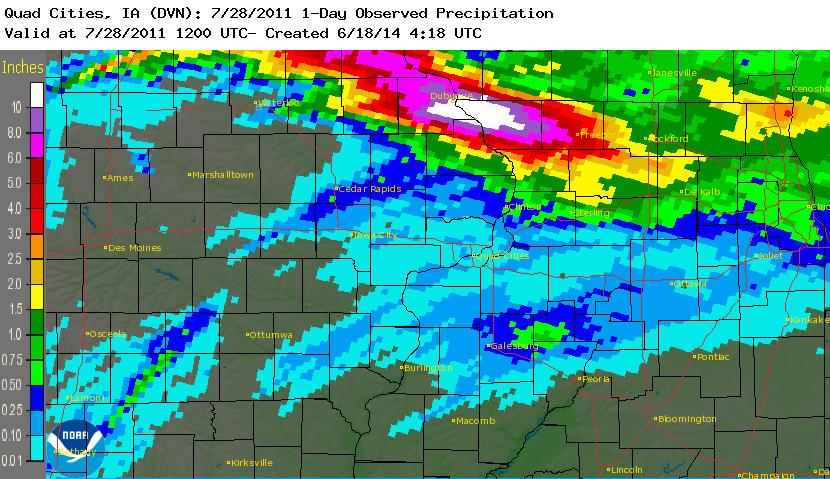A storm complex known as a "mesoscale convective system (MCS)" stalled along a frontal boundary over northeast Iowa. Thunderstorms developed repeatedly on the back of the storm and then "trained" across the same areas generally along the Highway 20 corridor. The heaviest rain fell from near Dyersville, IA to Dubuque, IA to Stockton, IL. With abundant moisture feeding into the storm system and the repetitive development, rainfall totals reached record levels in Dubuque and extreme flash flooding resulted. Numerous roads were washed out and many others closed.
A stationary, back building MCS stalled along a cold front that bisected Iowa from southwest to northeast. The MCS was fed by 30 to 40 kt low level jet and precipitable water values well over 2 inches.
With the tremendous rainfall amounts, the official weather observation site at the Dubuque airport broke several rainfall records:
|
Radar Estimate of Storm Total Rainfall |
Radar Estimate of 24-hour Rainfall |
 |
|
Official Rainfall Reports from Cooperative Observers (24 hour totals ending at 7 am on 7/28)
NORTHEAST IOWA...
DUBUQUE AIRPORT 10.31 in.
DUBUQUE LOCK&DAM 11 8.80 in.
NORTHWEST ILLINOIS... APPLE RIVER CANYON STATE PARK 7.50 in. ELIZABETH 5S 9.52 in. FREEPORT 5.35 in. GALENA 13.45 in. MOUNT CARROLL 2.89 in. STOCKTON 3NNE 7.14 in.
Supplemental Rainfall Reports from CoCoRAHS Observers
ILLINOIS GALENA 5.7 E 10.00 in. FREEPORT 2.0 NW 5.40 in. ORANGEVILLE 2.8 NW 2.11 in.
IOWA
BELLEVUE 0.3 SSW 4.95 in.
-------------------------------------------------------------------------------------
